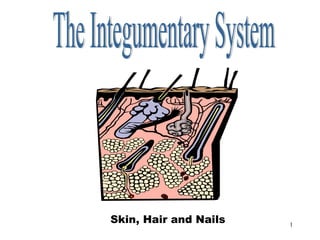
Understanding the Integumentary System
- 1. Integumentary System Skin, Hair and Nails 1
- 2. Skin is the largest organFunction and Structure and of the body, serves to: •Protect against injury •Protect against the sun UV rays •Prevent entry of harmful microorganisms •Maintain the proper internal body temperature •Excrete waste materials through perspiration •Function as a sense organ 2
- 3. Three Layers of theSkin Three Layers of Skin Epidermis Dermis Nerves, vessels, glands, hair follicles Subcutaneous/Hypodermis 3
- 4. epidermis Epidermal Epidermal Layer Layer •Outermost skin layer •Consists of several sublayers •Keratin – protein that makes skin tough and waterproof by preventing fluids et al from passing through the skin •Constantly replaced •Melanin – pigment that gives skin its color 4
- 5. Dermal Layer Dermal Layer dermis •“True skin” •Holds many capillaries, lymph cells, nerve endings, sebaceous and sweat glands and hair follicles •Arrector pili – cause goosebumps •Touch, temperature and •Thermoregulation pain sensation originate •Perspiration from dermis nerve cells •3rd degree burns 5
- 6. Subcutaneous Layer Subcutaneous Layer •Also called the hypodermis •Found between the dermal layer and the inner organs •Consists mostly of fatty tissues •Fatty tissue protects inner organs, maintains body temperature and stores energy •Blood vessels and nerves are present subcutaneous 6
- 7. Hair Hair - Protect and insulate •Grows out of the epidermis to cover parts of the body. •The shaft is what we see and the root lies below the surface of the skin. Hair color is determined by the presence of melanin. Baldness or alopecia may result from heredity, disease, injury, or chemotherapy. 7
- 8. Nails Nails •Nails are plates made of hard keratin upper surface of the fingers and toes. •Grows throughout life •At the base of most nails a lunula or whitish half-moon is an area where keratin and other cells have mixed with air. •The cuticle is a narrow band of epidermis that surrounds the base or bottom of nails. 8
- 9. Glands Glands •Sebaceous glands secrete sebum outward toward the surface of the body and are located almost everywhere on the body. •Sweat glands maintain normal temperature through perspiration Types of sweat glands Eccrine Apocrine Produce sweat to cool body Produce sweat of no use Forehead, palms and soles Armpits, genitals 9
- 10. Viral Rashes Symptoms, Abnormalities, and Conditions Viral Rashes rubeola rubella roseola varicella 10
- 11. Other Conditions Other Conditions •Impetigo, a highly contagious skin condition is caused by staphylococci and characterized by the presence of pus. •Ringworm or tinea is caused by fungi, and is characterized by intense itching or pruritis. •Common rashes such as diaper rashes are also caused by fungi known as Candidiasis. 11
- 12. Common Fungi Other Common Fungi •tinea pedis (athlete’s foot) •tinea capitis (scalp ringworm) •tinea barbae (ringworm of the beard) 12
- 13. Vascular Conditions Vascular Conditions •Ecchymosis Bluish-purple skin mark may be due to injury. •Petechiae Tiny pinpoint ecchymosis. •Purpura Extensive skin hemorrhages covering a wide area. •Rosacea Appears as red blotches on the skin, 13 especially the nose and cheeks.
- 14. Skin Conditions Related to Skin Conditions Related to Pigmentation Pigmentation •Leukoderma •Vitiligo •Albinism •Chloasma Vitiligo 14
- 15. Categories of Burns Burns to the skin may result from exposure to heat, chemicals, electricity, radiation or other irritants. Categories of Burns •First Degree •Third Degree is superficial, without involves complete blistering, but with destruction of skin redness and swelling. and sometimes reaches muscle •Second Degree and bone. involves the epidermis and dermis and blistering. 15
- 16. Conditions Caused by Insects Some skin conditions are caused by insects. Pediculosis An inflammation with Scabies lice usually on the Contagious skin head or genitals. eruption that often occurs between fingers, on areas of the trunk, or male genitalia and is caused by mites. 16
- 17. Surgical Terms Various types of plastic surgery may involve reconstructing areas of the skin. Other types involve removing part of a growth to test for cancer or removing the entire cancerous growth. 17
- 18. Apply Your Knowledge Part 2 Which of the following patients would experience the most pain following their burn injury? Patient A accidentally spilled hot grease on his his right hand and arm resulting in first and second degree burns to the entire area. -OR- Patient B was in his home when his kerosene heater fell on his left lower leg causing complete third degree burns to the area. Answer: Patient A 18